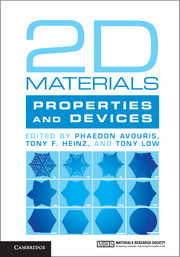2D Materials Properties and Devices
Langue : Anglais
Coordonnateurs : Avouris Phaedon, Heinz Tony F., Low Tony

A comprehensive and accessible introduction to 2D materials, covering basic physics, electronic and optical properties, and potential applications.
Learn about the most recent advances in 2D materials with this comprehensive and accessible text. Providing all the necessary materials science and physics background, leading experts discuss the fundamental properties of a wide range of 2D materials, and their potential applications in electronic, optoelectronic and photonic devices. Several important classes of materials are covered, from more established ones such as graphene, hexagonal boron nitride, and transition metal dichalcogenides, to new and emerging materials such as black phosphorus, silicene, and germanene. Readers will gain an in-depth understanding of the electronic structure and optical, thermal, mechanical, vibrational, spin and plasmonic properties of each material, as well as the different techniques that can be used for their synthesis. Presenting a unified perspective on 2D materials, this is an excellent resource for graduate students, researchers and practitioners working in nanotechnology, nanoelectronics, nanophotonics, condensed matter physics, and chemistry.
1. Graphene: basic properties Mikhail I. Katsnelson and Annalisa Fasolino; 2. Electrical transport in graphene: carrier scattering by impurities and phonons Jian-Hao Chen; 3. Optical properties of graphene Feng Wang and Sufei Shi; 4. Graphene mechanical properties C. DiMarco, R. Li, S. Rastogi, J. Hone and J. W. Kysar; 5. Vibrations in graphene Ado Jorio, Luiz Gustavo Cançado and Leandro M. Malard; 6. Thermal properties of graphene: from physics to applications Alexander A. Balandin; 7. Graphene plasmonics Frank Koppens, Mark B. Lundeberg, Marco Polini, Tony Low and Phaedon Avouris; 8. Electron optics with graphene p-n junctions James R. Williams; 9. Graphene electronics Chen Wang, Xidong Duan and Xiangfeng Duan; 10. Graphene: optoelectronic devices Thomas Mueller and Phaedon Avouris; 11. Graphene spintronics Aron W. Cummings, Sergio O. Valenzuela, Frank Ortmann and Stephan Roche; 12. Graphene-BN heterostructures Lei Wang, James Hone and Cory. R. Dean; 13. Controlled growth of graphene crystals by chemical vapor deposition: from solid metals to liquid metals Dechao Geng and Kian Ping Loh; 14. Electronic properties and strain engineering in semiconducting transition metal dichalcogenides Rafael Roldán and Francisco Guinea; 15. Valley-spin physics in 2D semiconducting transition metal dichalcogenides Hongyi Yu and Wang Yao; 16. Electrical transport in MoS2, a prototypical semiconducting TMDC Andras Kis; 17. Optical properties of TMD heterostructures Pasqual Rivera, Wang Yao and Xiaodong Xu; 18. TMDs - optoelectronic devices Thomas Mueller; 19. Large area synthesis Yumeng Shi and Lain-Jong Li; 20. Defects in two-dimensional materials Xiaolong Zou and Boris I. Yakobson; 21. Theoretical overview of black phosphorus Tony Low, Andrey Chaves, Wei Ji, Jesse Maassen and Traian Dumitrica; 22. Anisotropic properties of black phosphorus Yuchen Du, Zhe Luo, Han Liu, Xianfan Xu and Peide D. Ye; 23. Optical properties and optoelectronic applications of black phosphorus Andres Castellanos-Gomez and Mo Li; 24. Silicene, germanene and stanene Guy Le Lay, Eric Salomon and Thierry Angot; 25. Predictions of single-layer honeycomb structures from first-principles S. Ciraci and S. Cahangirov.
Phaedon Avouris is an IBM Fellow Emeritus. He is a member of the National Academy of Sciences, and a Fellow of the American Academy of Arts and Sciences, the American Physical Society, the Institute of Physics, the Institute of Electrical and Electronics Engineers (IEEE), the Materials Research Society, and the American Association for the Advancement of Science.
Tony F. Heinz is a Professor of Applied Physics and Photon Science at Stanford University, California and the SLAC National Accelerator Laboratory. He previously worked at Columbia University, New York and IBM Research, USA.
Tony Low is Assistant Professor of Electrical and Computer Engineering at the University of Minnesota. He previously worked at Yale University, Connecticut, Columbia University, New York, and the IBM T. J. Watson Research Center, New York.
Tony F. Heinz is a Professor of Applied Physics and Photon Science at Stanford University, California and the SLAC National Accelerator Laboratory. He previously worked at Columbia University, New York and IBM Research, USA.
Tony Low is Assistant Professor of Electrical and Computer Engineering at the University of Minnesota. He previously worked at Yale University, Connecticut, Columbia University, New York, and the IBM T. J. Watson Research Center, New York.
Date de parution : 06-2017
Ouvrage de 523 p.
17.8x25.3 cm
Thème de 2D Materials :
© 2024 LAVOISIER S.A.S.



